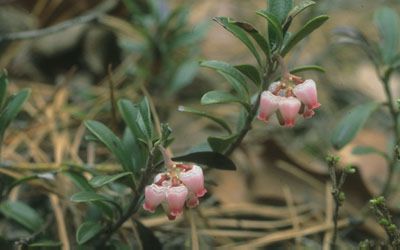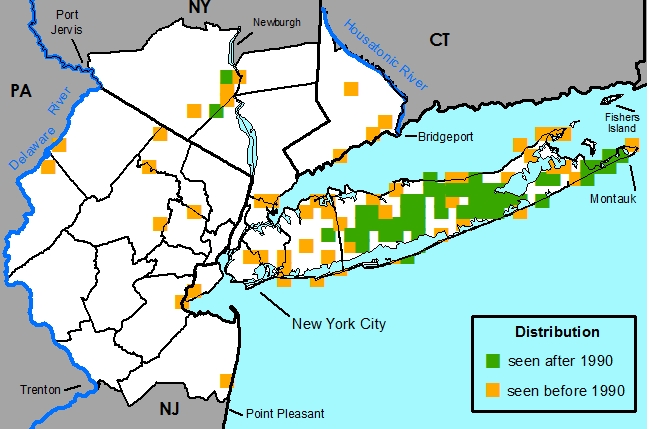Arctostaphylos uva-ursi (L.) Spreng. - Bearberry

Photo © by Peter Nelson
Taken in the Pine Barrens, NJ, 1978.
Native , Frequent
By Steven Clemants
Not peer reviewed
Last Modified 04/08/2013

Common Names
BearberryField Identification
A low-growing shrub with evergreen, obovate leaves and red fruits. Often growing in sandy dry soils.Food uses
Disclaimer: The information provided here is for reference and historical use. We do not recommend nor do we condone the use of this species for food purposes without first consulting a physician.The leaves are used to make a tea in some parts of Russia, where it is known as Kutai and Cacausian Tea.
Medicinal uses
Disclaimer: The information provided here is for reference and historical use. We do not recommend nor do we condone the use of this species for medicinal purposes without first consulting a physician.(Grieve, 1971) (Hare et al., 1905) (Hussey, 1974) (Uphof, 1968)
The dried leaves collected in the autumn are known as "Uvaursi", an astringent, tonic, and diuretic. It is of great value is treating diseases of the bladder and kidney as well as inflammatory diseases of the urinary tract, urethritis, cystitis, chronic bronchitis, diarrhea, leukorrhea, amenorrhea, and uterine hemorrhage. The chief constituent is arbutin, a powerful astringent. It also contains volatile oils and quercetin.
Other uses
(Grieve, 1971) (Hedrick, 1972) (Hussey, 1974) (Lewis & ElvinLewis, 1977) (Uphof, 1968)
Tannin is abundant in the leaves and is used for tanning leather in Scandinavia and Russia, where the leather produced is called Russian Leather. An ash-colored dye is made from the plant in Scandinavia. Leaves are mixed with tobacco and smoked by eastern North American indians and were also smoked by the early colonists.
Common names
Bearberry
Bear's Grape
Blanchnog
Brawlins
Burren Myrtle -- from growing on the Burren Limestone, Ireland.
Cranberry
Cranberry-Wire
Creashak
Crowberry
Dog-Berry
Foxberry
Gnashicks
Hog Cranberry
Kinnikinnick
Mealyberry
Moanagus
Nashag
Rapper-Dandy
Red Bearberry
Rockberry
Sagochomi
Sandberry
Nomenclature
*Arbutus uva-ursi L., Sp. Pl. 395. 1753. *Uvaursi procumbens Moench, Methodus 470. 1794, nom. illeg. (Art. 52.1). *Arbutus buxifolia Stokes, Bot. Mat. Med. 2: 509-510. 1812, nom. illeg. (Art. 52.1). *Mairania uva-ursi (L.) Desv., J. Bot. (Desvaux) 1: 37, 292. 1813, nom. illeg. (Art. 52.1). *Uva-ursi buxifolia Gray, Nat. Arr. Brit. Pl. 2: 400. 1821, nom. illeg. (Art. 52.1). *Arctostaphylos uva-ursi (L.) Spreng., Syst. Veg. 2: 287. 1825. *Arctostaphylus officinalis Wimm. & Grab., Fl. Siles. 1: 391. 1827, nom. illeg. (Art. 52.1). *Arctostaphylos procumbens (Moench) Patze, E. Mey. & Elkan, Fl. Preuss. [2:]188. 1849, nom. illeg. (Art. 52.1). *Uva-ursi uva-ursi (L.) Britton & A. Br., Ill. Fl. N.U.S., ed. 2, 2: 693. 1913, nom. inval. (Art. 23.4). TYPE: Type not designated, several elements.
*Arbutus ursina E. H. L. Krause in Sturm, Deutschl. Fl., ed. 2, 9: 228, pl. 54. 1901. TYPE: Type not cited.
*Daphnidostaphylos fendleriana Klotzsch, Linnaea 24: 80. 1851. *Arctostaphylos uva-ursi var. fendleri (Klotzsch) Eastw., Leafl. W. Bot. 4: 269. 1946. TYPE: United States. New Mexico: near Santa Fe, A. Fendler 546 (Holotype: probably B, destroyed; Isotypes: GH! #00055522, US!). [leaves dull]
*Arctostaphylos uva-ursi var. alba Cockerell, W. Amer. Sci. 6: 11. 1889. TYPE: Type not cited, probably from Custer Co., Colorado. [small white flowers]
*Arctostaphylos uva-ursi var. coactilis Fernald & J. F. Macbride, Rhodora 16: 211-213. 1914. *Uva-ursi uva-ursi var. coactilis (Fernald & J. F. Macbride) House, New York State Mus. Bull. 254: 551. 1924, nom. illeg. (Art. 23.4). *Uva-ursi procumbens var. coactilis (Fernald & J. F. Macbride) Moldenke, Boissiera 7: 5. 1943, nom. illeg. (Art. 52.1). *Arctostaphylos uva-ursi ssp. coactilis (Fernald & F. P. Macbride) Á. Löve, D. Löve & B. M. Kapoor, Arctic & Alpine Res. 3: 155. 1971. *A. uva-ursi f. coactilis (Fernald & F. P. Macbride) Wells, Madroño 35: 339. 1988. TYPE: United States. Maine: Brunswick, 18 May 1909, E. B. Chaimberlain s.n. (Holotype: GH! barcode #00014693). [branchlets canescent-tomentulose, not viscid, the minute tomentum persistent]
*Arctostaphylos uva-ursi var. coactilis f. heterochroma Fernald, Rhodora 35: 350. 1933. TYPE: United States. Massachusetts: Wellfleet, 9 Oct 1932, G. B. Rossbach et al. 2551 (Holotype: GH! barcode #0014694; Isotypes: GH! [2 sheets, barcode #00014695 & 00022301], US!, photo NY neg. 11127, NY!, photo NY neg. 9758). [fall-flowering, large, deep red corollas]
Description
HABIT perennial, evergreen, chamaephyte, shrubs, autotrophic, monoclinous, with adventitious roots or with fibrous roots, 0.12-0.2 m tall, not modified.
STEMS prostrate or decumbent, round, not winged, "regular". Prickles absent. Bark smooth, exfoliating, gray or reddish orange. Branches ascending, gray or reddish orange, round, not winged, 1.3-2 mm in diam. Twigs orange-red or violet-red, not odoriferous, ridged, 0.5-1 mm in diam., smooth, hairs short and unbranched or hairs long and unbranched, spreading, unicellular, uniseriate, white, moderately dense, throughout, glabrescent, without glands. Pith present, light yellowish orange, round, continuous, nodal diaphragm absent. Thorns absent. Aerial roots absent. Sap translucent. Resin absent.
LEAVES alternate, 1 per node, crowded toward stem apex, divergent from stem, simple. Stipules absent. Leaves petiolate, petiole "typical", 0.2-0.4 cm long, hairs long and unbranched, erect or spreading, unicellular, uniseriate, moderately dense, throughout, glabrescent, without glands. Leaf: abaxial surface dark green, adaxial surface green, blades elliptic or obovate, plane, symmetric, 1.5-2.3 cm long, 0.5-1.2 cm wide, coriaceous, base cuneate, margin entire, apex obtuse or retuse, abaxial surface hairs long and unbranched, erect or spreading, unicellular, uniseriate, white, sparse, along midveins and marginally, not glabrescent, without glands, adaxial surface glabrous, without glands. Eucamptodromous venation, veins 1. Leaf lobes absent. Spines absent. Tendrils absent.
INFLORESCENCES monomorphic, regular or, if dimorphic, female inflorescence simple, corymbose cyme, terminal. Peduncle present, 0.1-0.2 cm long. Rachis present, 0.4-0.5 cm long, with bracts. Bracts sessile, blades: abaxial surface green or reddish orange, adaxial surface green or reddish orange, linear triangular or linear obtriangular, explicative, 2.4-5.2 mm long, 1-2.3 mm wide, base truncate, margin entire, apex obtuse or acuminate (long (acuminate) on distal bracts), abaxial surface hairs short and unbranched, abaxial hairs erect, unicellular, uniseriate, white, moderately dense, throughout, not glabrescent, without glands, adaxial surface hairs short and unbranched, erect, unicellular, uniseriate, white, moderately dense, throughout, glabrescent, without glands. Pedicel 2.4-5.2 mm long, glabrous, without glands. Bracteoles 2, sessile, at base of pedicel, not connate, bracteoles: abaxial surface reddish orange, bracteole: adaxial surface reddish orange, cuneate, conduplicate-involute, 0.7-1 mm long, 0.6-1 mm wide, base truncate, margin entire, apex acute or obtuse. Cupules absent.
FLOWERS serotinous, formed on short shoots, monomorphic, with sepals and petals readily distinguishable from one another, bisexual, flowers white or red, 4-merous, 2.8-6.2 mm long, 3.9-4.5 mm wide, 5-6 flowers per inflorescence, perianth of two whorls. Calyx present, actinomorphic, of free sepals, deciduous, abaxial and adaxial surfaces the same color, reddish orange, 1.5 mm long, 3.5 mm wide. Sepals or sepal lobes 5, trullate, 0.8-1.3 mm long, 1-1.6 mm wide, base obtuse, margin entire, apex obtuse, abaxial surface glabrous, without glands, adaxial surface glabrous, without glands. Epicalyx absent. Corolla present, actinomorphic, urceolate, of fused petals, deciduous, abaxial and adaxial surfaces the same color, white or light red, uniform, 4.8-6.2 mm long, 3.9-4.5 mm wide, corolla limb 5-8 mm long, 1.2-2 mm wide. Petals or petal lobes 5, trullate, 0.8-1 mm long, 0.7-1 mm wide, base obtuse, margin minutely ciliate, apex obtuse, abaxial surface glabrous, without glands, adaxial surface glabrous, without glands. Gynoecium syncarpous. Carpels 4-10. Stigmas 1, capitate. Styles not persistent, 1, 2-3.3 mm long. Ovary superior, 1.4 mm long, 1.1 mm wide, nectiferous disk present. Locules 4-10. Placentation axile. Androecium obdiplostemonous. Stamens 10, 1.5 mm long. Anthers oblong, opening by pores, opening 1/4 of entire anther, bithecal, dark reddish violet, glabrous, awned. Filaments free, straight, light yellowish orange, hairs long and unbranched, erect, unicellular, uniseriate. Staminodes absent.
FRUITS drupe or bacca, red or dark red, globose, 8-10 mm long, 8-10 mm wide, glabrous, without glands.
SEEDS 5 (?), white (cream), oblong, 3-4.5 mm long or 6 mm long (for pit), 1.2-2 mm wide or 5.5 mm wide (for pit), wingless, not tailed, reticulate-areolate (?).
Habitat
(Reschke, 1990) (Wherry, 1920) (Wherry, 1920)
Dwarf pine plains, pitch pine-oak-heath woodlands and occasionally on cliffs or hills inland. Dry sand or stony soils with a pH of 4.5-5.
Rarity Status
Heritage global rank -- G5Connecticut -- not listed
New Jersey -- not listed
New York -- not listed
Species Biology
Flowering(April [week 2]) May [weeks 1-4].
Pollination
(Grevillius & Kirchner, 1923) (Hagerup, 1954) (Warming, 1908)Autogamy -- If wind is kept away then little seed set occurs.
Melittophily -- Some Bombus species visit but usually too late to effect pollination.
Fruiting
(May [week 4]) June [week 4] - Nov [week 2].
Dispersal
(Vines, 1960)Endozoochory -- Drupes eaten by "at least 18 species of birds including ruffed grouse, dusky grouse, Richardson's grouse, spruce grouse, sharp-tailed grouse, and wild turkey; also browsed by ... white-tailed deer" (Vines, 1960).
Germination
(Berg, 1974) (Giersbach, 1937) (Peseckiené, 1972) (Young & Young, 1992)Scarification required -- The embryos are dormant and surrounded by a hard seed coat with a micropyle that is plugged at maturity. They can remain viable for 3 years. Scarification with acid is usually necessary, the amount of time being variable for the seed. This is then followed by warm and cold stratification.